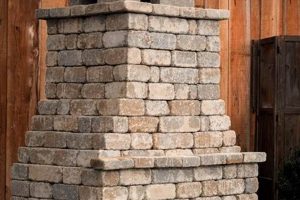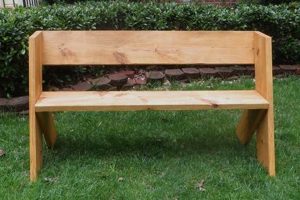The construction of a temporary viewing surface for projecting films in an open-air environment, undertaken by the individual rather than purchased pre-made, constitutes a significant element of at-home entertainment. This often involves readily available materials such as lumber, fabric, and basic hardware to establish a personal cinematic experience.
The appeal stems from the adaptability to specific spatial needs and budgetary constraints. It also fosters a sense of accomplishment and personalization unavailable with commercial alternatives. Historically, open-air film viewings were communal events, but modern construction allows for intimate, private screenings.
Subsequent sections will delve into various design approaches, material selection criteria, and essential construction techniques for creating a functional and visually appealing structure. This information will empower the reader to successfully implement their own individualized projection system.
Practical Advice for Building a Projection Surface
Constructing a stable and effective projection surface requires careful planning and execution. The following advice aims to optimize the viewing experience and ensure the longevity of the structure.
Tip 1: Screen Material Selection: Opt for a matte white or gray fabric designed specifically for projection screens. This will minimize glare and maximize contrast, leading to a superior image quality. Avoid glossy materials, which can reflect ambient light and degrade the projected image.
Tip 2: Frame Construction: A sturdy frame is essential for maintaining a taut and wrinkle-free surface. Utilize pressure-treated lumber or metal tubing for weather resistance and structural integrity. Ensure all joints are securely fastened to prevent warping or sagging.
Tip 3: Tensioning the Surface: Employ a consistent tensioning method, such as grommets and bungee cords or a staple gun, to stretch the material evenly across the frame. Uneven tension can lead to distortions in the projected image.
Tip 4: Surface Smoothness: Prior to securing the material, meticulously inspect the frame for any imperfections, such as splinters or sharp edges. These can damage the projection surface and compromise its overall quality. Padding the frame with felt or foam can provide an extra layer of protection.
Tip 5: Environmental Considerations: Account for prevailing winds and potential obstructions when choosing the location. A sheltered area will minimize the risk of the surface being blown over and ensure an unobstructed viewing angle.
Tip 6: Screen Size and Aspect Ratio: Determine the optimal screen size based on the projector’s throw distance and the viewing distance. Adhering to standard aspect ratios (e.g., 16:9) will prevent image distortion and ensure compatibility with most video sources.
Tip 7: Portability and Storage: If portability is a priority, consider a folding or collapsible frame design. This will facilitate easy transportation and storage when the surface is not in use. Protective covers can also extend the lifespan of the material.
By adhering to these guidelines, individuals can construct a durable and visually effective viewing surface. This enhances the outdoor cinematic experience and ensures optimal image quality.
The subsequent section will address common troubleshooting scenarios and explore advanced customization options.
1. Material Selection
The choice of materials significantly impacts the performance and longevity of a self-constructed open-air projection screen. Inadequate materials can lead to poor image quality, structural instability, and premature deterioration, thereby diminishing the overall viewing experience and negating the cost-effectiveness of the endeavor. For instance, utilizing a low-grade fabric with high reflectivity will result in excessive glare and washed-out colors. Conversely, selecting a dimensionally unstable frame material will cause sagging and image distortion over time.
The primary consideration for the projection surface itself is its ability to evenly diffuse light. Matte white or gray fabrics specifically designed for projection are optimal, as they minimize specular reflection and maximize contrast. Muslin, canvas, or blackout cloth are often employed as affordable alternatives, though their performance may be less consistent. Frame construction typically involves wood, metal, or PVC. Wood offers ease of construction but requires weather treatment to prevent rot and warping. Metal provides superior strength and durability but may be more challenging to work with. PVC offers a lightweight and weather-resistant option but may lack the rigidity needed for larger screens.
Effective selection necessitates balancing cost, performance, and ease of use. While specialized projection fabrics offer the best image quality, their expense may be prohibitive. A more practical approach involves choosing readily available materials and implementing careful construction techniques to mitigate their inherent limitations. The ultimate goal is to create a functional and aesthetically pleasing viewing surface that enhances the outdoor cinematic experience without incurring excessive costs or requiring specialized skills.
2. Frame Stability
The structural integrity of the frame is paramount in the creation of a functional open-air projection surface. Insufficient rigidity in the frame directly compromises the viewing experience by allowing the projection surface to warp, sag, or become susceptible to wind interference. This instability results in image distortion, inconsistent focus, and an overall degradation of the visual clarity, thus undermining the purpose of the setup.
A frame constructed from substandard materials or with inadequate joinery will exhibit flexing under its own weight or when subjected to even mild wind conditions. For example, a wooden frame utilizing thin lumber and unsecured joints will likely bow inward, causing the projection surface to wrinkle. Similarly, a PVC frame lacking reinforcement can bend or collapse, rendering the entire setup unusable. These issues not only detract from the viewing experience but also pose a safety hazard, particularly in windy environments. The selection of appropriate materials, such as pressure-treated lumber or metal tubing, coupled with robust construction techniques like mortise-and-tenon joints or welded connections, is crucial for ensuring a stable and durable frame.
In conclusion, the connection between frame stability and the success of a “do-it-yourself outdoor cinema screen” is direct and undeniable. A stable frame provides the necessary foundation for a taut, smooth projection surface, ensuring optimal image quality and a safe viewing environment. Neglecting this aspect will invariably lead to a compromised and potentially unusable setup. Therefore, prioritizing frame stability through careful material selection and robust construction is essential for achieving a successful and enjoyable outdoor cinematic experience.
3. Surface Tension
Surface tension, in the context of open-air film projection setups, refers to the degree to which the projection material is stretched and secured across the frame. It is a crucial factor influencing image quality and overall viewing experience.
- Image Distortion
Insufficient tension results in wrinkles, creases, or sagging on the projection surface. These imperfections cause light to scatter unevenly, leading to distortions in the projected image. This manifests as uneven brightness, blurred areas, and an overall reduction in visual clarity.
- Wind Resistance
Proper tension increases the surface’s resistance to wind. A taut surface is less likely to flap or billow in the breeze, minimizing movement that would disrupt the projected image. This is particularly important in outdoor environments where wind conditions can be unpredictable.
- Focus Uniformity
Uneven tension can create variations in the surface plane, making it difficult to achieve consistent focus across the entire screen. Areas with slack will appear blurred, while tighter areas may be in focus. This inconsistency detracts from the viewing experience and can cause eye strain.
- Material Longevity
Maintaining consistent tension distributes stress evenly across the projection material. This prevents localized stress points that could lead to tearing or premature wear. A properly tensioned surface is more likely to withstand prolonged use and environmental exposure.
Therefore, achieving optimal surface tension is a fundamental aspect of constructing a viable “diy outdoor cinema screen.” Proper tensioning techniques, such as using grommets and bungee cords or carefully stapling the material to the frame, are essential for ensuring a high-quality viewing experience and prolonging the life of the projection surface.
4. Image Quality
In the context of a self-assembled open-air projection system, image quality represents the fidelity and clarity of the visual display projected onto the screen. It is a critical determinant of the overall viewing experience and warrants careful consideration throughout the design and construction process.
- Projector Capabilities
The projector itself is a primary factor governing image quality. Resolution, brightness (lumens), contrast ratio, and color accuracy are key specifications. A projector with insufficient brightness will result in a washed-out image, particularly in environments with ambient light. Lower resolution projectors will display pixelation, diminishing the visual clarity. Inadequate contrast compromises the distinction between dark and light areas, reducing the overall depth and detail of the image. The projector’s specifications must align with the intended screen size and viewing environment to achieve optimal results.
- Screen Material Properties
The composition and characteristics of the screen material exert a significant influence on image quality. The material’s reflectivity, diffusion properties, and color neutrality affect the brightness, contrast, and color accuracy of the projected image. Matte white or gray materials are commonly employed for their ability to diffuse light evenly, minimizing glare and maximizing viewing angles. However, the specific properties of the material should be selected based on the projector’s capabilities and the ambient light conditions. For instance, a darker gray screen may enhance contrast in environments with moderate ambient light.
- Ambient Light Conditions
Ambient light, encompassing both natural and artificial sources, represents a substantial challenge to achieving optimal image quality. Ambient light reduces contrast, washes out colors, and diminishes overall brightness. Selecting a location with minimal ambient light is crucial. When complete darkness is unattainable, employing a higher lumen projector and utilizing a screen material with enhanced gain can mitigate the impact of ambient light. Furthermore, directing or shielding the screen from direct light sources can significantly improve the viewing experience.
- Viewing Angle and Distance
The viewer’s position relative to the screen influences the perceived image quality. Excessive viewing angles can result in diminished brightness, color shifts, and geometric distortions. Similarly, an inappropriate viewing distance can lead to pixelation or an inability to perceive fine details. The optimal viewing angle and distance are determined by the screen size, projector resolution, and the viewer’s visual acuity. Adhering to recommended viewing guidelines ensures a comfortable and immersive viewing experience.
These factors, when addressed comprehensively, contribute to maximizing image quality in a “do-it-yourself outdoor cinema screen” setup. Careful selection of components, coupled with diligent attention to environmental conditions, are essential for realizing a satisfying and visually compelling viewing experience.
5. Portability
Portability, within the context of a self-constructed open-air projection system, refers to the ease with which the entire setup can be transported and reassembled at different locations. This characteristic is a significant consideration for individuals seeking flexibility in their outdoor entertainment options.
- Frame Disassembly and Reassembly
The design of the frame directly impacts portability. Modular frame designs, incorporating easily detachable sections and lightweight materials like aluminum or PVC, facilitate simpler disassembly and transportation. Hinged designs also allow for folding the frame into a more compact form factor. Complex, permanently assembled frames, conversely, pose significant logistical challenges for relocation.
- Screen Material Storage and Transport
The projection surface material must be stored and transported in a manner that prevents damage, such as creases, tears, or stains. Rolling the material around a rigid core, as opposed to folding, minimizes the risk of wrinkles. A protective carrying case or bag safeguards the material during transit. Bulky or easily damaged materials can negate the portability benefits of a well-designed frame.
- Overall Weight and Size
The cumulative weight and dimensions of the assembled screen and frame are primary determinants of portability. Lighter materials and compact designs translate directly into easier handling and transportation. Larger, heavier setups require more manpower and potentially specialized vehicles for relocation, thus diminishing their practical portability.
- Setup and Teardown Time
The efficiency with which the screen can be erected and dismantled is a crucial aspect of portability. Complex designs requiring extensive assembly processes diminish the practical value of a theoretically portable system. Quick-release mechanisms, intuitive assembly procedures, and minimal tool requirements contribute to faster setup and teardown times, enhancing overall portability.
Ultimately, the value of portability in a “do-it-yourself outdoor cinema screen” is contingent upon the user’s intended application. A permanently installed screen prioritizes stability and image quality, while a portable screen sacrifices some of these aspects for increased versatility and the ability to enjoy outdoor cinema experiences in diverse locations.
6. Environmental Factors
The successful implementation of a self-constructed outdoor projection system is intrinsically linked to prevailing environmental conditions. Wind, temperature fluctuations, precipitation, and ambient light levels exert considerable influence on the system’s performance, longevity, and overall viability. Failure to adequately address these elements can result in compromised image quality, structural damage, or complete operational failure. For example, sustained exposure to direct sunlight can degrade the projection surface material, leading to discoloration and reduced reflectivity, while strong winds can destabilize the frame, causing the projected image to waver or even topple the entire structure.
The selection of materials and construction techniques must account for the specific environmental challenges presented by the intended location. For instance, pressure-treated lumber or corrosion-resistant metal should be employed for the frame in regions with high humidity or frequent rainfall. The projection surface should be fabricated from a material capable of withstanding temperature extremes and UV radiation. Furthermore, the orientation of the screen should be carefully considered to minimize direct exposure to sunlight and prevailing winds. Practical applications of this understanding include utilizing weighted bases or anchoring systems to secure the frame against wind gusts and incorporating protective covers to shield the screen from inclement weather when not in use.
Effective mitigation of environmental factors is not merely a matter of aesthetic preference but a practical necessity for ensuring the long-term functionality and enjoyment of a “diy outdoor cinema screen.” The interplay between environmental forces and the system’s design dictates its resilience and operational effectiveness. By acknowledging and proactively addressing these challenges, individuals can optimize their outdoor viewing experience and extend the lifespan of their self-constructed projection system.
Frequently Asked Questions
This section addresses common inquiries regarding the construction and utilization of a self-made open-air projection system. The information provided aims to clarify typical points of confusion and offer practical guidance.
Question 1: What is the optimal screen size for a personal outdoor cinema setup?
The appropriate screen size is contingent upon projector specifications, specifically throw distance and lumen output, and intended viewing distance. A general guideline is to ensure the screen subtends an adequate visual angle for comfortable viewing. Projector manuals provide recommendations for optimal screen size based on these parameters.
Question 2: Which type of projection material yields the best image quality?
Matte white or gray projection screen fabrics are generally preferred due to their ability to diffuse light evenly and minimize glare. The specific choice depends on ambient light conditions and projector capabilities. Darker gray screens enhance contrast in moderately lit environments, while brighter white screens are suitable for darker settings.
Question 3: How can wind interference be minimized during outdoor screenings?
Selecting a sheltered location is the primary method for reducing wind interference. Additionally, employing a robust frame design with weighted bases or anchoring systems can enhance stability. Securing the projection material tautly to the frame also minimizes movement caused by wind gusts.
Question 4: What safety precautions should be observed when operating an outdoor cinema?
Electrical safety is paramount. Extension cords should be rated for outdoor use and protected from moisture. Securing all cables prevents tripping hazards. The projector and screen should be positioned away from flammable materials. In adverse weather conditions, the setup should be disassembled to prevent damage or injury.
Question 5: Is it feasible to construct a portable screen for easy transport?
Yes, portable designs incorporating lightweight materials, modular frame sections, and foldable screens are achievable. However, portability often necessitates compromises in screen size and frame stability. Prioritizing weight reduction and ease of assembly are key considerations for a portable system.
Question 6: How does ambient light affect projected image quality and what steps can be taken to mitigate it?
Ambient light reduces contrast and washes out colors. To mitigate these effects, higher lumen projectors should be employed, and projection should be conducted during periods of darkness. Selecting a screen material with higher gain can also improve brightness under ambient light conditions.
In summation, careful planning, appropriate material selection, and adherence to safety guidelines are essential for a successful and enjoyable outdoor cinematic experience. The answers provided offer foundational knowledge for navigating the challenges inherent in creating a self-made projection system.
The following section will explore advanced customization options and potential enhancements to further optimize the outdoor cinema setup.
Conclusion
The preceding analysis underscores the multifaceted nature of crafting a “diy outdoor cinema screen.” From material selection and frame stability to image optimization and environmental considerations, the process demands meticulous planning and execution. Neglecting any of these critical elements invariably leads to a compromised viewing experience.
Ultimately, the success of this endeavor hinges on a thorough understanding of both the technical requirements and the environmental challenges inherent in open-air projection. While commercial alternatives exist, the satisfaction derived from constructing a personalized cinema space offers unique value, provided the requisite attention is given to detail and precision.







